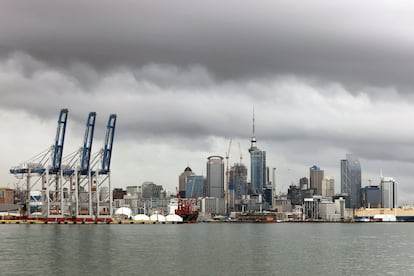New Zealand, the trading partner of almost every country in the world
The island country has just closed a new deal with the European Union, while managing to maintain a diplomatic balance with China, its largest foreign market

For New Zealand, having only five million inhabitants and being thousands of nautical miles away from the global supply chain are by no means insurmountable obstacles. The country has demonstrated that economic development can be achieved with a strategy based on cultivating competitive advantages and forging trade agreements with the rest of the world.
With a per capita income comparable to that of the United Kingdom, the island nation in the southwestern Pacific Ocean recently signed a free trade agreement with the European Union. Concluded this past July and set to enter into force by 2024, official estimates show that it will increase trade between New Zealand and the EU by 30%.
New Zealand — which has the ideal conditions for raising cows and sheep — has long been using a high-tech strategy to bolster its agricultural sector. Today, dairy products are the country’s number one export, followed by meat. The tourism sector is close behind in terms of generating income.
The free trade agreement between Brussels and the former British colony follows one that was signed between New Zealand and the U.K. in 2022. And, before that, Wellington inked more than 10 deals with several of its trading partners, including the Regional Comprehensive Economic Partnership (RCEP) — which consists of 15 countries, among them China, Japan and Australia — and the Trans-Pacific Partnership (TPP), which commercially links New Zealand to 10 countries in the Americas, Asia and Oceania, including Peru, Chile and Canada (the United States withdrew).
According to economist Shamubeel Eaqub, New Zealand’s tradition of opening up to the world began with the U.K.’s entry into the European common market — a move that left New Zealand without the preferential treatment that was once reserved for members of the Commonwealth. “It was a bit like our homeland had cut the umbilical cord,” he says. In the opinion of Eaqub — who works in Wellington for the Sense Partners consultancy — the importance of free trade agreements (such as the one signed with Brussels) has more to do with the possibilities of commercial homogenization and shared knowledge, rather than with the benefits of a reduction in prices and tariffs. This is principally because average tariffs are already too low for their removal to have a significant effect. According to the World Trade Organization, the average tariff under the most-favored-nation principle is 9%. But it’s also because the protection that Brussels grants to Europe’s dairy sector — a sector where New Zealand has a clear competitive advantage — takes the form of non-tariff barriers that Europe doesn’t plan on eliminating.
Rather than focusing on reducing tariffs and barriers, the free trade agreement between Europe and New Zealand emphasizes the inclusion of environmental and social restrictions, such as equality between men and women, and the measurement of carbon emissions generated by production and transport. Eaqub notes that “what we need is more coordination — especially when it comes to climate change — where one of the problems is that the lack of action by some discourages action by others.”
Critically, Wellington’s main trading partner isn’t the EU — it’s China. More than 30% of New Zealand’s direct exports go there, followed by Australia and the United States. As New Zealand economic historian Brian Easton explains, the percentage can be as high as 65% when exports to other countries in Asia and Oceania are included, most of which are subsequently integrated into China’s supply chain.
This importance of China explains the mild stance that the New Zealand government takes on Beijing’s human rights violations. Although Wellington has joined several international complaints about the abuses in Hong Kong and Xinjiang, the government — led by the Labour Party — continues to publicly defend its commercial relationship with the Asian giant. Simultaneously, it signs trade agreements with London and Brussels, while asking its businesspeople to expand into new markets.
“The most dire scenario for New Zealand would be a collapse of the Chinese economy, or a military conflict between the Asian country and the United States involving sanctions against Beijing,” Easton emphasizes. Hence, he explains, a diplomatic policy that walks “on tiptoes.”
“New Zealand needs to condemn some of China’s actions, but not very strongly, so as to avoid commercial repercussions like those suffered by Australia,” Easton warns. China is currently waging a trade war with New Zealand’s neighbor, which was triggered by statements made by former Australian Prime Minister Scott Morrison about the origins of Covid-19. “On the other hand, [Wellington] needs to affirm its security relationship with the United States, to ensure that New Zealand’s main exports are respected in a possible scenario of trade sanctions against Beijing… but it cannot be so close [to D.C., otherwise] China will find this intolerable.”
Inflation and rate hikes
As with many developed economies around the world, New Zealand is dealing with an increase in housing prices, a difficulty that has become especially pressing following the pandemic.
According to data from Jarrod Kerr — the chief economist at Kiwibank, a state-owned bank — in just 18 months, real estate prices shot up by 45%. While prices have subsequently fallen by about 15% since November 2022, buying a home still represents eight times the median annual household income. On average, to make a single mortgage payment, about half of the average wage is required, according to calculations by Brad Olsen of the Infometrics consultancy.
According to Kerr, the increase in housing prices was driven by a long period of low interest rates, which put mortgage loans “at 2% or 2.5%.” The increase may also have been triggered by a change in the way of thinking that followed the 2020–2021 lockdowns. “Many of the people who spent so much time cooped up at home started looking for better houses,” he notes. The problem is that the rate hike deployed by the Reserve Bank of New Zealand may now put them in trouble, as they struggle to pay the interest on their mortgages.
To combat inflation — which reached a high of 7.3% in June and is now at around 6% — the country’s central bank had to raise its interest rate to 5.5%, to discourage borrowing and cool the overheated economy. While the monetary authorities have given signals that there will be no further increases, the prevailing system of taking out a mortgage — which combines fixed interest with variable interest — has rattled homeowners and potential homeowners. According to Christina Leung — of the New Zealand Institute of Economic Research — “around half of the mortgages that are going to have to be renegotiated in the next 12 months will go from rates of 4% to rates of 6%, 7% or 8%, so even if the Reserve Bank isn’t going to raise its rate any further, for at least one or two years, we’re going to have those interest rates stuck at up to 8%.”
Sign up for our weekly newsletter to get more English-language news coverage from EL PAÍS USA Edition
Tu suscripción se está usando en otro dispositivo
¿Quieres añadir otro usuario a tu suscripción?
Si continúas leyendo en este dispositivo, no se podrá leer en el otro.
FlechaTu suscripción se está usando en otro dispositivo y solo puedes acceder a EL PAÍS desde un dispositivo a la vez.
Si quieres compartir tu cuenta, cambia tu suscripción a la modalidad Premium, así podrás añadir otro usuario. Cada uno accederá con su propia cuenta de email, lo que os permitirá personalizar vuestra experiencia en EL PAÍS.
¿Tienes una suscripción de empresa? Accede aquí para contratar más cuentas.
En el caso de no saber quién está usando tu cuenta, te recomendamos cambiar tu contraseña aquí.
Si decides continuar compartiendo tu cuenta, este mensaje se mostrará en tu dispositivo y en el de la otra persona que está usando tu cuenta de forma indefinida, afectando a tu experiencia de lectura. Puedes consultar aquí los términos y condiciones de la suscripción digital.
More information
Archived In
Últimas noticias
There is as much life left to discover on planet Earth as that which is already known
Dozens presumed dead, around 100 injured in fire at Swiss Alps bar during New Year’s celebration
Is porn for women different from conventional porn? We spoke to those who make it
Cartagena de Indias is sinking: What can the city do to mitigate it?
Most viewed
- Sinaloa Cartel war is taking its toll on Los Chapitos
- Reinhard Genzel, Nobel laureate in physics: ‘One-minute videos will never give you the truth’
- David King, chemist: ‘There are scientists studying how to cool the planet; nobody should stop these experiments from happening’
- Oona Chaplin: ‘I told James Cameron that I was living in a treehouse and starting a permaculture project with a friend’
- The Interoceanic Train, the Mexican alternative to the Panama Canal










































